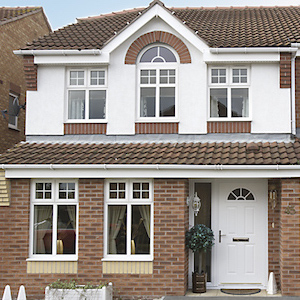A Window in the Door: More than Just a Pane of Glass
In the beginning look, a window in a door might seem like a simple architectural function. It's just a piece of glass that allows light to filter through or offers a peek of what's on the other side, right? But when you stop briefly to think about it, this seemingly ordinary element carries considerable functional, visual, and even symbolic weight. Whether it graces the doors of your home, office, or favorite café, a window in a door is even more than just a pane of glass-- it's a bridge between spaces.
1. Performance: The Practical Role of Door Windows
The addition of a window to a door offers useful benefits that can improve both domestic and industrial spaces:
Natural Light: One of the primary functions of a window in a door is to allow sunlight to travel through. In areas with restricted windows or enclosed locations like hallways or interior offices, this function can brighten the area, lower the reliance on synthetic lighting, and create a more inviting atmosphere.
Presence and Safety: A window in a door provides a clear line of sight for those on either side. This is specifically essential in commercial and commercial settings, such as dining establishments, factories, or schools, where people frequently move through doors. Visibility minimizes the risk of mishaps (e.g., someone walking into a door or hitting somebody on the other side).
Ventilation and Energy Efficiency: When combined with operable glass or modern-day innovations like double-glazing and low-E glass, door windows can add to better air blood circulation and energy performance in your home or work space.
Security: While breaking glass may appear like an open invite to burglars, modern designs have addressed this problem. Strengthened glass, tempered glass, or designs with narrow panes can make the window resistant to forced entry while still serving the functions of visibility and light.
2. Aesthetic Appeal: Enhancing the Visual Identity of a Space
From a style viewpoint, windows in doors can raise aesthetic appeal in various methods:
Design and Character: The style of the window frequently matches the architectural vibe of the home. A home with a rustic or farmhouse look might feature a door with frosted or stained glass, while a streamlined, modern-day home may display a minimalist door with basic, tidy lines.
Modification: Door windows come in numerous shapes and sizes-- round, rectangle-shaped, oval, arched, or custom-made to match your preferences. This versatility provides homeowners and designers the capability to produce doors with creative flair and individual touches.
Curb Appeal: The entry door is often the focal point of a home's exterior, and a well-designed window within it can turn an otherwise ordinary door into a vibrant design statement. french doors with side windows or etched glass, for example, can communicate sophistication and beauty.
3. Meaning and Meaning: Beyond the Practical and Aesthetic
On a much deeper level, a window in a door carries symbolic significances that resonate throughout cultures and contexts:
Openness and Connection: A door with a window promotes a sense of connection between two discrete areas. Whether it's between a house and its front lawn or a workplace conference room and a corridor, the window can make these spaces feel less isolated and more incorporated.

Transparency: In work environments, doors with windows represent openness and responsibility. A manager's office with a glass-panel door, for example, can signify approachability, lowering the hierarchical barrier that a solid closed door may produce.
A Threshold of Opportunity: Metaphorically speaking, a door with a window can represent a view into new opportunities. It provides a sneak peek into what lies ahead-- a fitting image for individual growth and exploration.
4. Modern Trends: Innovations in Door Window Design
Advances in innovation and style are continuously reshaping how we think of door windows. Here are a few trends to see:
Smart Glass: With the development of wise innovation, windows that can alter from transparent to opaque with the touch of a button are getting appeal. These high-tech options provide personal privacy as needed without compromising the advantages of natural light.
Energy Efficiency: Double- and triple-glazed door windows with advanced insulation are ending up being requirement in energy-conscious homes. These not just keep your energy costs in check however also minimize environmental impact.
Decorative Enhancements: Patterns, etching, and colored glass inserts are becoming more intricate, offering property owners unlimited possibilities to personalize their doors.
Safety Upgrades: Impact-resistant glass and shatter-proof films are significantly being incorporated into door windows, particularly in locations prone to storms or high-security needs.
5. Factors to consider for Choosing a Door with a Window
Before choosing a door with a built-in window, there are a few elements property owners and designers must remember:
Privacy: While a window provides exposure and natural light, it can also compromise personal privacy. Frosted glass or tactically put window styles can alleviate this concern.
Maintenance: Glass in doors will gather fingerprints, dirt, and spots, particularly in high-traffic areas. Choosing materials that are simple to tidy or have protective coverings can save time.
Integration with the Environment: Choose a door window design that complements the environments. A door in a peaceful, domestic community may prioritize aesthetic appeals, while one in a commercial building may stress toughness and safety.
Conclusion: A Small Feature with Significant Impact
As basic as it might seem, a window in a door is a function that mixes practicality with appeal, security with style, and connection with uniqueness. It's a pointer that the tiniest details in architecture can have the power to transform not just our areas but also the way we communicate with them.
Whether you're peering through a glass panel to welcome a guest or letting natural light filter into your home, a window in a door is far more than a design element-- it's a way to open ourselves to the world, one pane of glass at a time.
